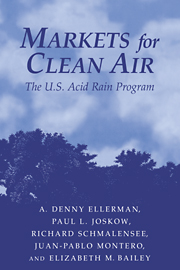Book contents
- Frontmatter
- Contents
- List of Illustrations
- List of Tables
- Preface
- Acknowledgments
- Part I Background
- 1 A Market-Based Experiment
- 2 A Political History of Federal Acid Rain Legislation
- 3 The Political Economy of Allowance Allocations
- 4 The Pre-1995 Trend in SO2 Emissions
- Part II Compliance and Trading
- Part III Questions and Implications
- Appendix: Effect of Title IV on SO2 Emissions and Heat Input by Susanne M. Schennach
- Bibliography
- Index
4 - The Pre-1995 Trend in SO2 Emissions
Published online by Cambridge University Press: 10 December 2009
- Frontmatter
- Contents
- List of Illustrations
- List of Tables
- Preface
- Acknowledgments
- Part I Background
- 1 A Market-Based Experiment
- 2 A Political History of Federal Acid Rain Legislation
- 3 The Political Economy of Allowance Allocations
- 4 The Pre-1995 Trend in SO2 Emissions
- Part II Compliance and Trading
- Part III Questions and Implications
- Appendix: Effect of Title IV on SO2 Emissions and Heat Input by Susanne M. Schennach
- Bibliography
- Index
Summary
EXPECTED VERSUS ACTUAL SO2 EMISSIONS
When acid rain legislation was being debated, SO2 emissions were expected to rise throughout the 1990s as a result of the increase in the demand for electricity and continuing reliance on coal-fired generation. For example, in a 1990 analysis of the proposed acid rain legislation, a widely recognized consultant to government and industry predicted that, without acid rain controls, electric utility SO2 emissions would rise by as much as 25% over the 1985 level by the year 2005 (ICF, 1990). Other forecasts, with lower load growth or more gas generation, projected smaller increases in emissions, but none forecast a decrease. In fact, however, 1990 SO2 emissions from electric utilities were 3% below the 1985 level, and 1993 emissions were 7% below 1985 despite continuing growth in coal-fired generation. Even before the emission constraints embodied in Title IV could have affected the trend in SO2 emissions, the historical data indicate that emissions were falling rather than rising.
In this chapter, we discuss why SO2 emissions fell rather than rose after 1985 and develop methods to distinguish the impact of Title IV on SO2 emissions from the impact of other exogenous factors operating during this period. From the standpoint of the environment, any reduction in SO2 emissions, whatever the reason, may be viewed as welcome. However, an accurate estimate of the emission reductions due to Title IV is required for any evaluation of the costs of the Acid Rain Program.
- Type
- Chapter
- Information
- Markets for Clean AirThe U.S. Acid Rain Program, pp. 77 - 106Publisher: Cambridge University PressPrint publication year: 2000

